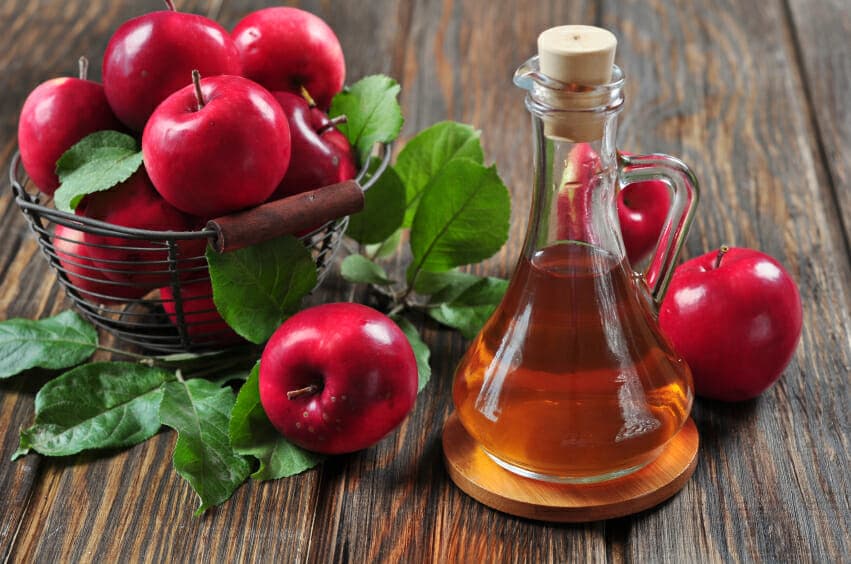Apple cider vinegar is a buzzword. In fact, it has been for years.
But what exactly is ACV? Where does it come from? What is its history? And do all of the different uses that you see for ACV touted online really work?
Let’s consider this unique wellness tool and safe and effective ways to implement it in a good wellness plan.
What Is Apple Cider Vinegar?

Let’s start with a quick and obvious question. What is apple cider vinegar in the first place? As the name implies, this is a form of vinegar sourced from apples.
Regular vinegar products typically form from grapes. The word itself comes from the French words “vin aigre,” which mean soured grapes.
In the case of ACV, the souring or spoiling is still taking place, but in this case, it’s with apples. As the apples decompose, yeast turns their sugars into alcohol, which bacteria then turn into acetic acid. This is called the “fermentation” process. This combination of yeast and bacteria is called the “mother,” and it is still present in many ACV products.
This means ACV with the mother has the potential to function as a probiotic. (It’s still difficult to be too bold with claims, as much of this science is still in the discovery process, and things like the manufacturing process of ACV products matter.)
ACV also contains acetic acid and is rich in vitamins and antioxidants from apples — all without the hefty dose of sugar. This makes it a nutrient-rich natural product.
The History of ACV
Asking when ACV first appeared on the historical record is similar to wondering when humans started eating apples. Records go back thousands of years reporting or, at the least, indicating that humans drank beverages and used liquids coming from fermented fruits — including apples. These reports geographically range from the Greeks and Romans to the Chinese.
The “Father of Medicine,” Hippocrates, used vinegar as an antiseptic. Mohammed referenced vinegar in the 7th century. The Spanish alchemist Geber recognized and isolated acetic acid around the year 800.
Across the centuries, people have used vinegar to disinfect during plagues, spice drinks, and preserve and pickle foods. It became popular in America around the year 1700 and has grown in status as a superfood since that time.
What Are the Benefits of ACV?
When used correctly, ACV can have many benefits for your body. However, don’t trust every claim you see.
The University of Chicago Medicine points out (link above) that “ACV is not pixie dust, but it’s also not snake oil.” It possesses many benefits that can provide important support when living a healthy life, including:
- Operating as an ingestible antibacterial agent.
- Helping control blood sugar levels.
- Functioning as an energy booster.
- Working as a potential appetite control and weight loss tool.
- Providing a way to improve digestion.
- Fermented to help diversify the microbiome.
These are all powerful benefits. However, putting them into practice requires some thoughtful application.
How to Use ACV Safely
While ACV has many benefits, it’s important to use it wisely. Here are a few common ways you can use apple cider vinegar in your health and wellness routines.
- Take ACV gummies: Most ACV applications are in the form of a drink or liquid solution. If beverages aren’t practical, you can take ACV in gummy form. Numo Gummies points out that if you take this route, you want to use a cold manufacturing process to preserve live and active cultures that would otherwise die during the high-heat methods of traditional gummy manufacturing.
- Make a diet-friendly ACV tonic: Healthline highlights the use of ACV both as a tonic to curb your appetite as well as an energy drink. You can either dilute it with water directly or add it to other beneficial ingredients, such as lemon juice, cinnamon, and cayenne pepper.
- Use it for a sore throat: ACV is an antimicrobial agent. Some studies even found it was effective against powerful strains, such as E coli and Staphylococcus aureus. Mixing even a small amount with water or other drinks can, at the least, help manage a sore throat.
There are many other applications for ACV out there. Just make sure that whatever you use your ACV for is safe and backed by sound science and proven facts.
Concerns With ACV
Finally, it’s important to take a moment to consider some of the concerns with ACV. Fortunately, this isn’t a long list, as the naturally fermented product is quite safe in most uses and cases.
However, it’s worth reiterating that it isn’t a magic bullet. ACV doesn’t have infinite applications. Nor is it a panacea for all health concerns.
In fact, larger amounts of ACV can be unhelpful and even harmful. Excessive intake can lead to a variety of side effects, from stomach aches to damaged tooth enamel.
Don’t take too much all at once. Instead, ease into using ACV, starting with small doses. In addition, never use it without watering it down and don’t apply it directly to your skin.
The ABCs of ACV
ACV is an ancient, effective health and wellness tool. It already has many positive applications and uses throughout everyday life, and researchers are regularly broadening that list.
Remember to look for wise ways to use ACV as a potent part of your wellness plan. From cold compress gummies to sore throat salves and much more, find ways to integrate ACV into cultivating a healthier, happier you.
